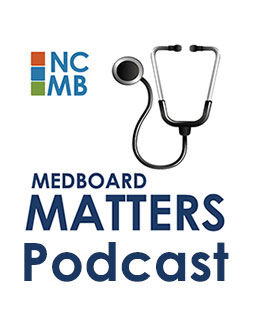Making the tough calls: inside the NCMB’s case review process
Categories: President’s Message Comments: 0 comments Print Friendly Version | Share this item A theme is emerging in my columns for this newsletter, perhaps even for my term as President of the Board: giving insight into how the NCMB does what it does. It’s my hope that doing so will foster more understanding and faith in the Board’s work, even when licensees and others may not agree with a specific decision.
A theme is emerging in my columns for this newsletter, perhaps even for my term as President of the Board: giving insight into how the NCMB does what it does. It’s my hope that doing so will foster more understanding and faith in the Board’s work, even when licensees and others may not agree with a specific decision. In this article I will discuss the process by which members of the Board, with input from the NCMB’s staff, resolve cases when there is a lack of consensus.
This subject occurred to me during a recent Board Meeting, as I listened to the deliberations of the NCMB’s Disciplinary Committee. The Disciplinary Committee is made up of six Board Members that review and make recommendations to the full Board in cases after Board staff recommends either public or private action. The President is an ad hoc member of all Board committees, and therefore non-voting. The President does, however, often attend and participate in committee discussions.
The normal process for Disciplinary Committee cases is to have the senior staff of the Board review and come to a consensus recommendation to the Committee. If the consensus is that the case should be closed with no action, the matter ends there. This happens in well over half of all cases. When there is no consensus, or if the staff feels action is indicated (either private or public) the case is forwarded to the Disciplinary Committee for consideration. Sometimes the Committee is unable to come to a consensus; in these situations, the full Board decides without the benefit of a committee recommendation.
During the most recent Board Meeting, the Disciplinary Committee discussed a handful of complaint cases in which the senior staff had been unable to agree whether the cases should be closed with no action, or the licensees in question should be sent private letters. Private letters of concern state the Board’s specific concerns and suggest ways the licensee should improve. The Committee had reviewed the complaint cases, including the licensee responses. Licensees are asked to respond in writing to the allegations in almost all complaint cases and do so in 100 percent of complaint cases reviewed by the Disciplinary Committee. These responses are critically important for the Board to make a fair decision.
As the Committee grappled with the issues in each complaint case, a discussion unfolded regarding the decision making process and the factors the Committee members should consider in reaching their recommendations to the full Board. The following viewpoints were presented:
It was suggested that the Committee should consider the portion of the Medical Practice Act that authorizes the NCMB to take action and not issue a private letter of concern unless the case involved a clear (if only minor) violation of the law. Absent a demonstrable violation, wouldn’t it be most prudent for the Board to close the case with no action?
The next point of view expressed noted that the case involved areas in which the licensee could do better. It was suggested that the Board has a role to play in helping licensees provide good quality care even when perceived deficiencies may not rise to the level of violations of law. Doesn’t the Board’s mission to regulate medicine for the benefit and protection of North Carolinians include offering assistance to licensees who show a need for improvement?
Another perspective expressed urged the Committee to remember its obligation to the patient. Sending the licensee a letter of concern, even a private one, is one way for the Board to demonstrate to the complainant that his or her concerns were taken seriously and that the complaint made a difference. Taking no action gives the patient the opposite impression, it was argued. Shouldn’t the Board consider the impact of sending the patient a message that the Board “didn’t do anything” about his or her complaint?
As I listened, it occurred to me how very valuable – indeed, essential – it is for the NCMB to include all of these different points of view in its deliberations.
We start with the complaint itself, and the licensee’s response. Then there is the law. We have the impulse to diagnose and attempt to treat the problems presented by the case. And, not least, we have the impact on the patient or family member making the complaint, reminding us that the Board’s actions, or lack thereof, speak volumes to the patients and other members of the public who trust the NCMB to act in their best interests. We have the Committee itself, both physicians and public members, adding their unique perspectives. Finally, there is discussion at the full Board level where a decision is rendered.
Therefore, we have the maximum number of perspectives weighing into decisions. Considering these different viewpoints is the Board’s greatest strength, as well as one of its greatest challenges.
I believe weighing these varying views allow us to come to the fairest conclusions for our licensees and the patients they serve.
This infographic illustrates the Board's process for making decisions about a case.
